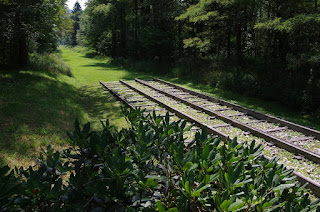August 4-8,
2019
Shawnee
State Park
Schellburg,
PA
So far we
have been very impressed with Pennsylvania State Park campgrounds.

We had wanted to spend a week at Shawnee but
could only get a site from Sunday through Thursday.
In addition
to our usual trip to the local Walmart for groceries we took a drive to tour
two different National Historic Sites, Allegheny Portage Railroad and Johnstown
Flood Memorial.
We began our
visit to the Allegheny Portage Railroad at the Visitor Center where we watched
a film and learned the site had the first railroad constructed through the
Allegheny Mountains in central Pennsylvania.
 Spanning 36 miles
and connecting the Midwest to the eastern seaboard, it was primarily used as a
portage railway, hauling river boats and barges over the divide between the
Ohio and Susquehanna Rivers between 1834 and 1854.
Spanning 36 miles
and connecting the Midwest to the eastern seaboard, it was primarily used as a
portage railway, hauling river boats and barges over the divide between the
Ohio and Susquehanna Rivers between 1834 and 1854.
The railway
consisted of five inclines on either side of the drainage divide. The endpoints connected to the Canal at
Johnstown on the west through Hollidaysburg on the east.
Wheeled
barges rode a narrow-gauge rail track with steam-powered engines lifting the
vehicles.
The railway
cut transport time from Philadelphia to the Ohio River from weeks to just 3-5
days.
It played a
critical role in opening the interior of the country beyond the Appalachian
Mountains to commerce and settlement.
The portage
railroad was rendered obsolete by the advance of railway technology in the late
1850s.
Outside the
Visitor Center we walked down the boardwalk through a stone quarry leading to
Incline Plane 6 which preserves the remains of the original engine house
foundation.
Half of the
exhibit shelter contains a reproduction of the machinery that would have been
in Engine House #6 including a stationary engine as well as the gears, brakes,
and assorted levers that kept the tow rope in motion.
Adjacent to
Incline Plane 6 is the Lemon House that served as its owners home, tavern, and
business.
Samuel Lemon operated the
business serving passengers of the newly built Allegheny Portage Railroad.
Gentlemen passengers would be welcomed into
the bar area while the ladies ate a hearty meal in the dining room followed by
a visit to the parlor.
The house
passed through various owners and was kept in different stages of repair until
the National Park Service acquired the site in 1966.
A short
drive or walking trail leads down to the Skew Arch. The arch is 80 feet 5 inches long on the
south elevation and 54 feet 11 inches long on the north elevation.
The stone
bridge was built for passage of a Turnpike road over the Railway.
After a
picnic lunch we drove twenty miles to the Johnstown Flood National Memorial.
The Visitor
Center contains two floors of exhibits and a theatre showing a film that used
excerpts from an old movie from the 1920s.
A dam was
built by the Commonwealth of Pennsylvania in 1853 as part of a cross-state
canal system with Johnstown as the eastern terminus supplied with water by Lake
Conemaugh. The canal was abandoned as
railroads superseded canal barge transport.
The
Pennsylvania Railroad purchased the dam and lake and sold it to private
interests.
The group of
speculators modified the canal to convert it into a private resort lake for
their wealthy associates.
 Included in
the development was lowering the dam to make its top wide enough to hold a road
and putting a fish screen in the spillway.
These alterations are thought to have increased the vulnerability of the
dam. And a system of relief pipes and
valves, features of the original dam were not replaced.
Included in
the development was lowering the dam to make its top wide enough to hold a road
and putting a fish screen in the spillway.
These alterations are thought to have increased the vulnerability of the
dam. And a system of relief pipes and
valves, features of the original dam were not replaced.
With the
establishment of the South Fork Fishing and Hunting Club, members, including
more than 50 wealthy Pittsburgh steel, coal, and railroad industrialists, built
cottages and a clubhouse.
In May,
1889, the heaviest rainfall that had ever been recorded in that part of the
United States turned small creeks into roaring torrents, ripping out trees.
After
assessing the situation, the president of the club assembled a group of men to
save the face of the dam by trying to unclog the spillway that was blocked by
the debris caused by the swollen waterline.
The first
town to be hit when the dam collapsed was South Fork located on high ground
where most of the people were able to escape.
As the water
flowed toward Johnstown it picked up debris such as trees, houses and animals.
The flood,
before hitting the main part of Johnstown, hit the Cambria Iron Works sweeping
up railroad cars and barbed wire.
Johnstown
residents were caught by surprise as the wall of water bore down, traveling 40
miles per hour and reaching a height of 60 feet.
Many people
were crushed by pieces of debris while others were caught in barbed wire.
The death
toll has been calculated at approximately 2,200. That number may be more or less as some who
were suspected as being victims later turned up alive. There is also not an accounting of people who
may have been visitors that were not counted as missing.
Bodies were found
as far away as Cincinnati and as late as 1911.
99 entire families died in the flood, including 396 children and 777
people were never identified.
The damage
has an estimated $17 million price tag and is considered the worst flood to hit
the U.S. in the 19th century.






























No comments:
Post a Comment